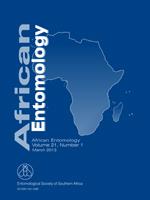Disturbance in habitat complexity and niche availability affect competitive interactions between faunal species which may result in their extinction. This study was conducted to assess the conservation value of four a priori selected sites, A: ‘minimally disturbed natural forest patch’, B: ‘herbaceous grassland patch’, C: ‘road verge patch’ and D: ‘highly disturbed natural forest patch’ using epigaeic invertebrate assemblages in Silaka Nature Reserve. A total of 2415 specimens belonging to three phyla (Arthropoda, Mollusca and Annelida) were caught from all sites using pitfall traps, and these were sorted into 14 orders, 15 families, 21 species and 17 morphospecies. Multivariate approaches using canonical correspondence analysis (CCA) showed that some measured site variables, e.g. litter depth, grazing intensity, soil pH, soil phosphorus content and texture (percentage clay and silt) accounted for species distribution trends across sites. Site A had both common/widespread and rare/typical invertebrate taxa, and therefore was of high value for conserving invertebrate biotic communities within the reserve. The other three sites also offered optimal and unique habitat requirements for protecting and preserving species such as Ancylotrypha zuluensis, Lycosidae sp. 2, and the Opiliones. Biotope management in the reserve should therefore aim at preserving a variety of habitat patches that differ in structural and compositional vegetation. Furthermore, anthropogenic pressures resulting from frequent clearing should be regulated especially during the summer to cater for various developmental (including immature) stages of the invertebrate assemblage of the reserve.
BioOne.org will be down briefly for maintenance on 14 May 2025 between 18:00-22:00 Pacific Time US. We apologize for any inconvenience.
How to translate text using browser tools
1 March 2013
Distribution and Diversity of Epigaeic Invertebrate Assemblages in Silaka Nature Reserve, Eastern Cape, South Africa
D.N. Forbanka,
A.S. Niba
ACCESS THE FULL ARTICLE
It is not available for individual sale.
This article is only available to subscribers.
It is not available for individual sale.
It is not available for individual sale.

African Entomology
Vol. 21 • No. 1
March 2013
Vol. 21 • No. 1
March 2013
environmental variables
invertebrate conservation
nature reserve




